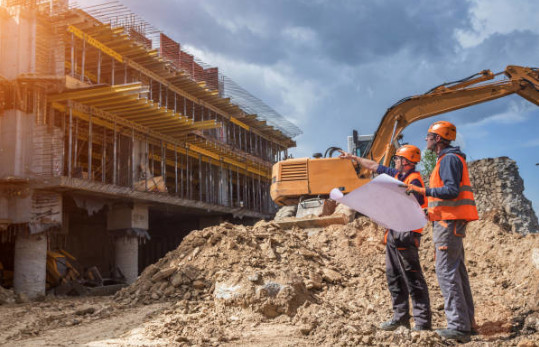Specialized Geotechnical Works for Lasting Construction Solutions
Wiki Article
How Consulting Engineers Enhance Geotechnical Engineering Projects: Insights Into Their Know-how, Methods, and Collaborative Approaches
Consulting engineers are pivotal in improving geotechnical engineering jobs, applying their specialized expertise to navigate the complexities of subsurface conditions. Their techniques incorporate a range of site examination methods, including Requirement Penetration Tests (SPT) and Cone Infiltration Tests (CPT), which notify vital decisions during the layout and building phases. Furthermore, their joint techniques foster communication amongst varied task stakeholders, eventually forming the task's trajectory. As we take a look at the diverse duties these experts play, it ends up being clear that their payments prolong beyond technological experience, motivating a more detailed take a look at the implications for job success.Duty of Consulting Engineers
The competence of consulting engineers in geotechnical engineering is essential to the effective execution of construction projects. These experts play a crucial role in evaluating dirt and rock buildings, which are important elements affecting design and building decisions. By carrying out complete website investigations, consulting designers collect vital data that educates the layout procedure, making sure jobs are developed on secure and appropriate ground.Consulting engineers also offer important insights into danger monitoring (geotechnical geologist). They identify potential geotechnical dangers, such as landslides, dirt liquefaction, and negotiation issues, allowing stakeholders to implement effective reduction methods. Their competence aids in optimizing foundation styles, which can cause substantial price savings and boosted security
Additionally, speaking with engineers work as a vital link in between task proprietors, designers, and service providers. Their capacity to translate complicated geotechnical data into workable suggestions promotes partnership and promotes informed decision-making throughout the project lifecycle. This multidisciplinary method not only boosts task effectiveness yet additionally makes certain compliance with regulatory requirements and best techniques.
Key Techniques in Geotechnical Design

One main method is site examination, which includes carrying out field tests and lab analyses to gather information on subsurface conditions. Methods such as Criterion Infiltration Testing (SPT) and Cone Penetration Testing (CPT) are widely used to examine dirt stratigraphy and toughness. In addition, geophysical methods, consisting of seismic and electric resistivity surveys, offer non-invasive methods to evaluate subsurface characteristics.
Another essential method is numerical modeling, which allows engineers to simulate numerous situations and predict how soil-structure communications will certainly behave under various loading conditions. Finite Element Evaluation (FEA) is a typical approach utilized in this context.
Moreover, the style of foundations, maintaining structures, and earthworks depends greatly on these techniques - geotechnical geologist. By incorporating advanced analytical tools with field information, getting in touch with engineers can create tailored services that attend to details task obstacles, inevitably adding to the security and security of construction projects
Significance of Soil Evaluation
Soil analysis offers as a fundamental component click to investigate in geotechnical engineering, giving necessary insights right into the physical and chemical residential properties of dirt required for effective building and construction preparation. Understanding soil qualities is important for identifying its load-bearing capability, water drainage actions, and capacity for settlement or instability. Detailed dirt investigations, consisting of sampling and research laboratory screening, help recognize criteria such as soil kind, wetness content, density, and shear strength.
These analyses notify the selection of proper building techniques and products, ultimately influencing job safety and security and long life. Natural soils may need various structure styles contrasted to granular soils, requiring tailored engineering solutions. Soil evaluation help in recognizing contaminants that can present dangers to human health and wellness or the setting, allowing for the advancement of reduction strategies.
Integrating soil analysis right into the onset of job growth assists to lessen unforeseen challenges, making sure that designers can prepare for and resolve possible problems prior to they intensify. By establishing an extensive understanding of the site conditions, consulting designers can optimize style performance and reduce expenses, thereby enhancing the overall success of geotechnical design projects.
Joint Strategies in Jobs
Successful geotechnical jobs usually pivot on collaborative strategies that combine diverse knowledge from different self-controls. Reliable cooperation amongst seeking advice from designers, geologists, environmental scientists, and construction professionals is important for dealing with intricate difficulties and enhancing task end results. By leveraging the one-of-a-kind skills and knowledge of each group participant, tasks can benefit from an all natural understanding of the site problems, governing requirements, link and design restraints.Regular interaction and interdisciplinary conferences promote the sharing of understandings and promote a society of team effort. These collective efforts allow the recognition of prospective risks early in the project lifecycle, enabling prompt reduction methods. Including feedback from stakeholders, including regional communities and regulatory firms, makes sure that all point of views are go to this site taken into consideration, boosting project acceptance and compliance.
In addition, the combination of innovative innovations, such as Geographic Info Solution (GIS) and Structure Info Modeling (BIM), further improves partnership. These devices enable the real-time sharing of information and visualization of geotechnical conditions, advertising notified decision-making. Inevitably, a collaborative method not just enhances project execution however likewise lays the foundation for innovative services to complex geotechnical engineering difficulties.
Effect On Job End Results

Consulting engineers use advanced techniques such as risk analysis and predictive modeling, which boost the accuracy of task forecasts. Their capacity to incorporate ingenious modern technologies, like geotechnical instrumentation and information analytics, even more refines the design and building processes. As a result, tasks experience improved efficiency, minimized prices, and reduced delays.
Furthermore, fostering effective communication and partnership among staff member enhances analytical abilities. When challenges arise, a united front enables swift recognition of solutions, stopping potential obstacles. Eventually, the collective efforts of speaking with engineers add to higher high quality results, making certain that tasks fulfill both governing criteria and client assumptions.
Conclusion

Report this wiki page